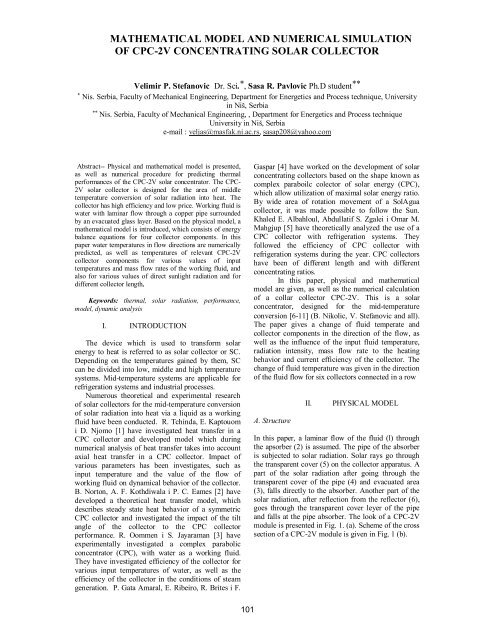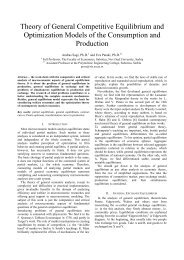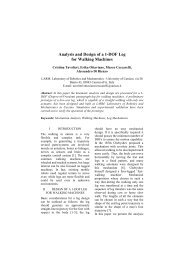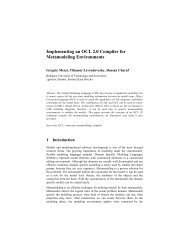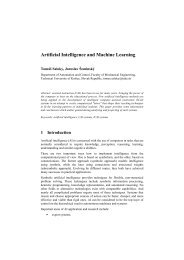At the sector level, this approach can contribute to thecreation of new incentive programs at the state orprovincial level, the promotion of new technologicalsolutions, and to providing subsidies for the most urgentand effective investment, as well as many otherpossibilities.Energy waste detection as a reactive approach is notproper for high demanded, complex and intensive energysystems. Efficiency forecasting by neural network methodis essentially preventive or proactive approach whichleads to avoiding inefficiency.Predictive analysis with reliable and relevant obtainedresults can assist in recommending and specifyingopportunities for reducing irrational energy use. Forprediction, the neural network model can simulate widescale of anticipated operational regimes and checkefficiency for different favorable or undesirable values ofinput parameters.VII. KEY CONSIDERATIONSIn all mentioned energy sectors, systemic solutionsrequired for improving the current situation in theRepublic of Serbia and also in the Province of Vojvodinado not exist. This particularly refers to the aspect ofenergy efficiency related to the introduction of energymanagement systems, modern energy andenvironmentally friendly technologies and regulatoryactivities aimed at improving the current situation.General recommendations are the improvement of care(through better maintenance) for plant resources, existenceand observing energy procedures, establishing evidence,measures and other activities which are aimed at systemicchanges and continuous care for energy and energy plantsand other aspects of boiler house operations. Suchsystematic approach in changing the situation andattitudes towards these issues is both important andnecessary. The change is equally important andindispensable not only for the community itself but alsofor end users of final energy [4].In the Republic of Serbia and also in the Province ofVojvodina, investments in energy efficiency are still agreat challenge for local authorities, policy makers andbusiness leaders. Very few public or commercialcompanies are aware of business benefits generated byefficient energy use and how it can help to cut costs andkeep them ahead of their competitors.The neural network method can assist in mentionedregional environment by recommendations and guidelinesfor activities such as applying improved operationalmanagement and procedures, efficient use of plant’sequipment, improving of care for plant’s resources,establishing evidence and improved measurements, etc.Such activities open preconditions for effective andsystemic changes and continuous care for energy andenergy plants and other aspects of boiler house operations.REFERENCES[1] Ayhan-Sarac B, Karlık B, Bali T, Ayhan T. Neural networkmethodology for heat transfer enhancement data. InternationalJournal of Numerical Methods for Heat & Fluid Flow, Vol. 17 No.8, 2007, pp. 788-798, 0961-5539, DOI10.1108/09615530710825774[2] Bevilacqua M, Braglia M, Frosolini M, Montanari R. Failure rateprediction with artificial neural networks, Journal of Quality inMaintenance Engineering, Vol. 11 No. 3, 2005, pp. 279-294,1355-2511, DOI 10.1108/13552510510616487[3] Gvozdenac D, Kljajic M. Technical and Economical Assessmentsof the Energy Efficiency of Boilers Improvement in the Provinceof Vojvodina, PSU-UNS International Conference on Engineeringand Environment - ICEE-2007, Thailand, 2007.[4] Morvay Z, Gvozdenac D. Applied Industrial Energy andEnvironmental Management, John Wiley & Sons, UK, 2008.[5] Dukelow G. S. The Control of Boilers, Instrument Society ofAmerica, USA, 1991.[6] Carpinteiro O, Lemeb R, de Souza A, Pinheiro C, Moreira E.Long-Term Load Forecasting via a Hierarchical Neural Modelwith time Integrators, Electric Power Systems Research 77 (2007)371–378[7] Rumelhart D, Hinton G, Williams R. Learning InternalRepresentations by Error Propagation, Parallel DistributedProcessing, Vol. 1, Chapter 8, MIT Press, pp. 318-362 1986.[8] Masters T. Practical Neural Network Recipes in C++. London:Academic Press Inc.; 1993[9] Good Practice Guide: Energy Efficient Operation of Boilers, theCarbon Trust, UK, 2004.[10] Good Practice Guide: An Introductory Guide to EnergyPerformance Assessment – Analyzing Your Own Performance,the Carbon Trust, UK, 2005.100
MATHEMATICAL MODEL AND NUMERICAL SIMULATIONOF CPC-2V CONCENTRATING SOLAR COLLECTORVelimir P. Stefanovic Dr. Sci. * , Sasa R. Pavlovic Ph.D student ***Nis. Serbia, Faculty of Mechanical Engineering, Department for Energetics and Process technique, Universityin Niš, Serbia**Nis. Serbia, Faculty of Mechanical Engineering, , Department for Energetics and Process techniqueUniversity in Niš, Serbiae-mail : veljas@masfak.ni.ac.rs, sasap208@yahoo.comAbstract-- Physical and mathematical model is presented,as well as numerical procedure for predicting thermalperformances of the CPC-2V solar concentrator. The CPC-2V solar collector is designed for the area of middletemperature conversion of solar radiation into heat. Thecollector has high efficiency and low price. Working fluid iswater with laminar flow through a copper pipe surroundedby an evacuated glass layer. Based on the physical model, amathematical model is introduced, which consists of energybalance equations for four collector components. In thispaper water temperatures in flow directions are numericallypredicted, as well as temperatures of relevant CPC-2Vcollector components for various values of inputtemperatures and mass flow rates of the working fluid, andalso for various values of direct sunlight radiation and fordifferent collector length.Keywords: thermal, solar radiation, performance,model, dynamic analysisI. INTRODUCTIONThe device which is used to transform solarenergy to heat is referred to as solar collector or SC.Depending on the temperatures gained by them, SCcan be divided into low, middle and high temperaturesystems. Mid-temperature systems are applicable forrefrigeration systems and industrial processes.Numerous theoretical and experimental researchof solar collectors for the mid-temperature conversionof solar radiation into heat via a liquid as a workingfluid have been conducted. R. Tchinda, E. Kaptouomi D. Njomo [1] have investigated heat transfer in aCPC collector and developed model which duringnumerical analysis of heat transfer takes into accountaxial heat transfer in a CPC collector. Impact ofvarious parameters has been investigates, such asinput temperature and the value of the flow ofworking fluid on dynamical behavior of the collector.B. Norton, A. F. Kothdiwala i P. C. Eames [2] havedeveloped a theoretical heat transfer model, whichdescribes steady state heat behavior of a symmetricCPC collector and investigated the impact of the tiltangle of the collector to the CPC collectorperformance. R. Oommen i S. Jayaraman [3] haveexperimentally investigated a complex parabolicconcentrator (CPC), with water as a working fluid.They have investigated efficiency of the collector forvarious input temperatures of water, as well as theefficiency of the collector in the conditions of steamgeneration. P. Gata Amaral, E. Ribeiro, R. Brites i F.Gaspar [4] have worked on the development of solarconcentrating collectors based on the shape known ascomplex paraboilc colector of solar energy (CPC),which allow utilization of maximal solar energy ratio.By wide area of rotation movement of a SolAguacollector, it was made possible to follow the Sun.Khaled E. Albahloul, Abdullatif S. Zgalei i Omar M.Mahgjup [5] have theoretically analyzed the use of aCPC collector with refrigeration systems. Theyfollowed the efficiency of CPC collector withrefrigeration systems during the year. CPC collectorshave been of different length and with differentconcentrating ratios.In this paper, physical and mathematicalmodel are given, as well as the numerical calculationof a collar collector CPC-2V. This is a solarconcentrator, designed for the mid-temperatureconversion 6-11 (B. Nikolic, V. Stefanovic and all).The paper gives a change of fluid temperate andcollector components in the direction of the flow, aswell as the influence of the input fluid temperature,radiation intensity, mass flow rate to the heatingbehavior and current efficiency of the collector. Thechange of fluid temperature was given in the directionof the fluid flow for six collectors connected in a rowA. StructureII.PHYSICAL MODELIn this paper, a laminar flow of the fluid (l) throughthe apsorber (2) is assumed. The pipe of the absorberis subjected to solar radiation. Solar rays go throughthe transparent cover (5) on the collector apparatus. Apart of the solar radiation after going through thetransparent cover of the pipe (4) and evacuated area(3), falls directly to the absorber. Another part of thesolar radiation, after reflection from the reflector (6),goes through the transparent cover leyer of the pipeand falls at the pipe absorber. The look of a CPC-2Vmodule is presented in Fig. 1. (a). Scheme of the crosssection of a CPC-2V module is given in Fig. 1 (b).101
- Page 1 and 2:
4 4 th IEEE International Symposium
- Page 3 and 4:
EXPRES 20124 th International Sympo
- Page 5 and 6:
Application of Thermopile Technolog
- Page 7 and 8:
Design of a Solar Hybrid System....
- Page 9 and 10:
___________________________________
- Page 11 and 12:
environmental protection and global
- Page 13 and 14:
But can we use the human body sweat
- Page 15 and 16:
IX. REFERENCES[1] Todorovic B. Cvje
- Page 17 and 18:
QQ⎛ Λt⎞=⎜⎟⎝ Λ ⎠Nt Nwh
- Page 19 and 20:
Analysis of the Energy-Optimum of H
- Page 21 and 22:
V. OBJECTIVE FUNCTIONThe objective
- Page 23 and 24:
The Set-Up Geometry of Sun Collecto
- Page 25 and 26:
continuous east-west sun collector
- Page 27 and 28:
continuously measure the thermal ch
- Page 29 and 30:
CEvaluation of measurement resultsA
- Page 31 and 32:
Application of Thermopile Technolog
- Page 33 and 34:
Temperature of the components [C]90
- Page 35 and 36:
nighttime, to weather or to the cha
- Page 37 and 38:
η uη u0.50.40.30.20.1T 1 - 400K0.
- Page 39 and 40:
Figure 10. . SPS Concept illustrati
- Page 41 and 42:
[16] Zoya B. Popović: Wireless Pow
- Page 43 and 44:
25.0020.0015.0010.005.000.00Figure
- Page 45 and 46:
· ℃ 0.0738 · 1.209 0.0892
- Page 47 and 48:
use may be advantageous not only in
- Page 49 and 50:
To find the reasons for this disagr
- Page 51 and 52: Toward Future: Positive Net-Energy
- Page 53 and 54: EnergyPlus environment, we used mod
- Page 55 and 56: To keep future energy consumption d
- Page 57 and 58: A New Calculation Method to Analyse
- Page 59 and 60: On Fig. 3. can be seen the areas th
- Page 61 and 62: Present and Future of Geothermal En
- Page 63 and 64: TABLE II.THE TEMPERATURE DATA AND C
- Page 65 and 66: Error in Water Meter Measuring at W
- Page 67 and 68: III.RESULTS OF MEASURMENTSEach meas
- Page 69 and 70: TABLE I.THE AVERAGE VALUE OF THERMA
- Page 71 and 72: If the walls of the DHEs are made o
- Page 73 and 74: Environmental External Costs Associ
- Page 75 and 76: iodiesel production facility with a
- Page 77 and 78: Contribution of unit processesto ex
- Page 79 and 80: Heat Pump News in HungaryBéla Ád
- Page 81 and 82: Thermal Comfort Measurements In Lar
- Page 83 and 84: IV.DISCUSSIONThe sample frequencies
- Page 85 and 86: For a Clear View of Traditional and
- Page 87 and 88: esults in geographically distribute
- Page 89 and 90: Design of a Solar Hybrid SystemMari
- Page 91 and 92: Maintaining the set point temperatu
- Page 93 and 94: Decision system theory model of ope
- Page 95 and 96: parameter of pump in the function o
- Page 97 and 98: Importance and Value of Predictive
- Page 99 and 100: D. Overview of existing boiler oper
- Page 101: HEAVY FUEL OIL FIRED, STEAMNATURAL
- Page 105 and 106: C. Energy balance equationMathemati
- Page 107 and 108: Discretization energy balance equat
- Page 109 and 110: T ulf=32 º C, A - m =0.00162 kg/s,
- Page 111 and 112: Comparison of Heat Pump and MicroCH
- Page 113 and 114: the microCHP development. The energ
- Page 115 and 116: control and stabilizer must be deve
- Page 117 and 118: In Figure 1, in relation to the ord
- Page 119 and 120: NPCC BHXOBYNI x1I x2I x3I x4LO YKYO
- Page 121 and 122: exchange, as in reality, economies
- Page 123 and 124: esponsibilities for consequences, o
- Page 125 and 126: Coca-Cola Enterprise Inc had approx
- Page 127 and 128: Flow Pattern Map for In Tube Evapor
- Page 129 and 130: circumference with a liquid film. T
- Page 131 and 132: Tube diameter: d 6 mm W Heat flux
- Page 133 and 134: Realization of Concurrent Programmi
- Page 135 and 136: applications the development, optim
- Page 137 and 138: Renewable energy sources in automob
- Page 139 and 140: commercial arrays can be built at b
- Page 141 and 142: of multiple thin films produced usi
- Page 143: EXPRES 20124 th International Sympo


